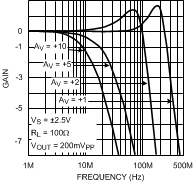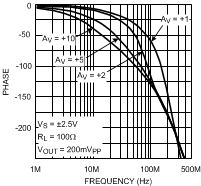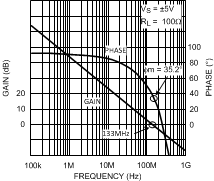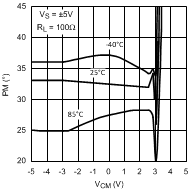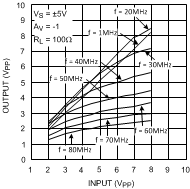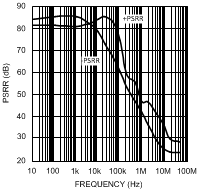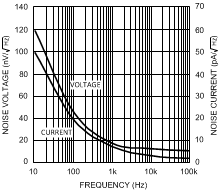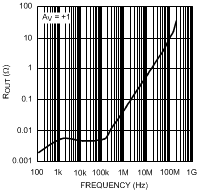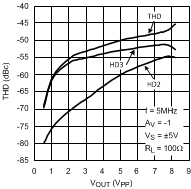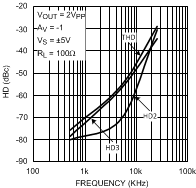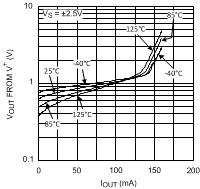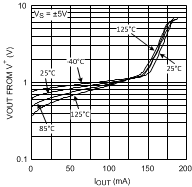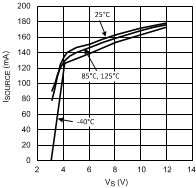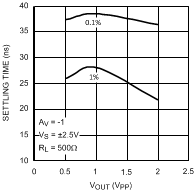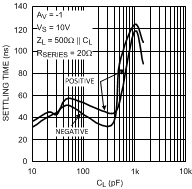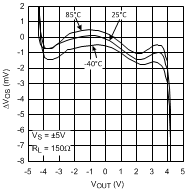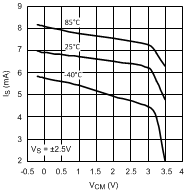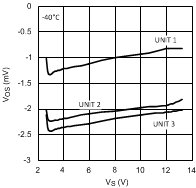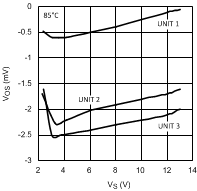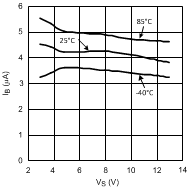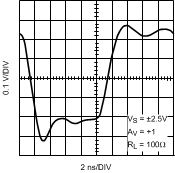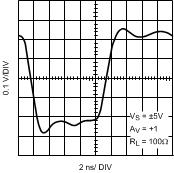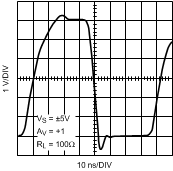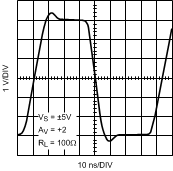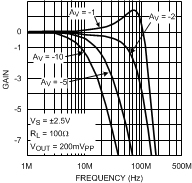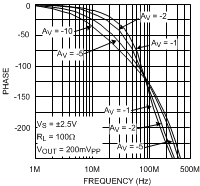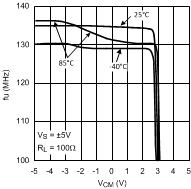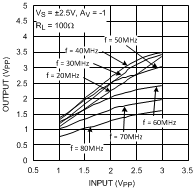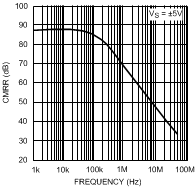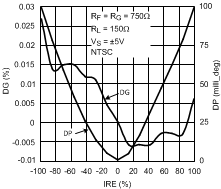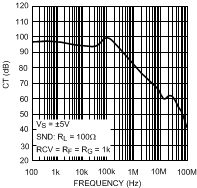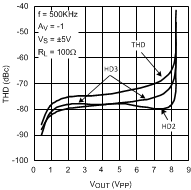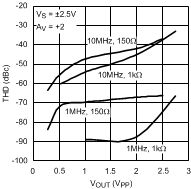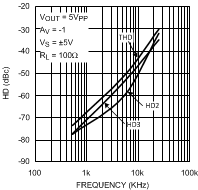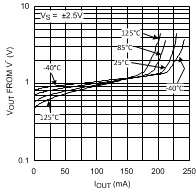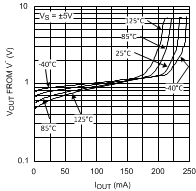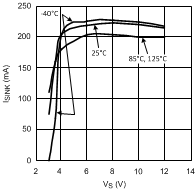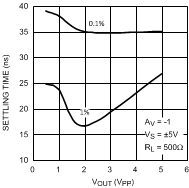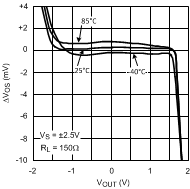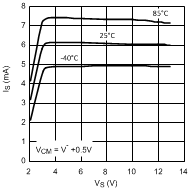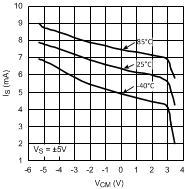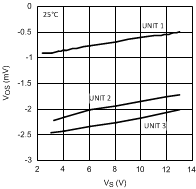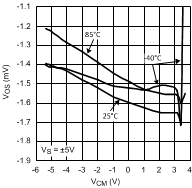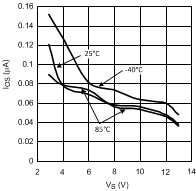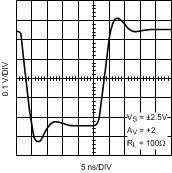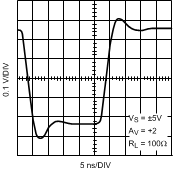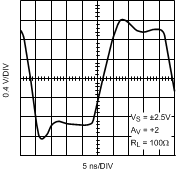SNOSA35G August 2002 – July 2015 LMH6657 , LMH6658
PRODUCTION DATA.
6 Specifications
6.1 Absolute Maximum Ratings
over operating free-air temperature range (unless otherwise noted)(1)| MIN | MAX | UNIT | ||
|---|---|---|---|---|
| VIN Differential | ±2.5 | V | ||
| Output Short Circuit Duration | See (2)(4) | |||
| Input Current | ±10 | mA | ||
| Supply Voltage (V+ - V−) | 12.6 | V | ||
| Voltage at Input/Output pins | V− − 0.8 | V+ + 0.8 | V | |
| Soldering Information | Infrared or Convection (20 sec.) | 260 | °C | |
| Wave Soldering (10 sec.) | 260 | |||
| Storage temperature, Tstg | –65 | 100 | °C | |
| Junction Temperature(3) | 150 | °C | ||
(1) Stresses beyond those listed under Absolute Maximum Ratings may cause permanent damage to the device. These are stress ratings only, which do not imply functional operation of the device at these or any other conditions beyond those indicated under Recommended Operating Conditions. Exposure to absolute-maximum-rated conditions for extended periods may affect device reliability.
(2) Applies to both single-supply and split-supply operation. Continuous short circuit operation at elevated ambient temperature can result in exceeding the maximum allowed junction temperature of 150°C.
(3) The maximum power dissipation is a function of TJ(MAX), RθJA, and TA. The maximum allowable power dissipation at any ambient temperature is PD = (TJ(MAX) - TA)/ RθJA . All numbers apply for packages soldered directly onto a PCB.
(4) Output short circuit duration is infinite for VS < 6 V at room temperature and below. For VS > 6 V, allowable short circuit duration is 1.5ms.
6.2 ESD Ratings
| VALUE | UNIT | |||
|---|---|---|---|---|
| V(ESD) | Electrostatic discharge | Human body model (HBM), per ANSI/ESDA/JEDEC JS-001(1)(3) | ±2000 | V |
| Machine Model(2) | ±200 | |||
(1) JEDEC document JEP155 states that 500-V HBM allows safe manufacturing with a standard ESD control process. Manufacturing with less than 500-V HBM is possible with the necessary precautions. Pins listed as ±2000 V may actually have higher performance.
(2) Machine Model, 0 Ω in series with 200 pF.
(3) Human body model, 1.5 kΩ in series with 100 pF.
6.3 Recommended Operating Conditions
over operating free-air temperature range (unless otherwise noted)| MIN | MAX | UNIT | ||
|---|---|---|---|---|
| Supply Voltage (V+ – V−) | 3 | 12 | V | |
| Operating Temperature(2) | −40 | 85 | °C | |
6.4 Thermal Information
| THERMAL METRIC(1) | LMH6657 | LMH6658 | UNIT | |||
|---|---|---|---|---|---|---|
| DBV (SOT-23) | DCK (SC70) | D (SOIC) | DGK (VSSOP) | |||
| 5 PINS | 8 PINS | |||||
| RθJA | Junction-to-ambient thermal resistance(2) | 265 | 478 | 190 | 235 | °C/W |
(1) For more information about traditional and new thermal metrics, see the Semiconductor and IC Package Thermal Metrics application report, SPRA953.
(2) The maximum power dissipation is a function of TJ(MAX), RθJA, and TA. The maximum allowable power dissipation at any ambient temperature is PD = (TJ(MAX) - TA)/ RθJA . All numbers apply for packages soldered directly onto a PCB.
6.5 Electrical Characteristics, 5 V
Unless otherwise specified, all limits ensured for at TJ = 25°C, V+ = 5 V, V− = 0 V, VCM = VO = V+/2, and RL = 100Ω (or as specified) tied to V+/2.| PARAMETER | TEST CONDITIONS | MIN(1) | TYP(2) | MAX(1) | UNIT | ||
|---|---|---|---|---|---|---|---|
| GB | Gain Bandwidth Product | VOUT < 200 mVPP | 140 | MHz | |||
| SSBW | −3-dB BW | AV = +1, VOUT = 200 mVPP | 220 | 270 | MHz | ||
| AV = +2 or −1, VOUT = 200 mVPP | 100 | ||||||
| GFP | Frequency Response Peaking | AV = +2, VOUT = 200 mVPP, DC to 100 MHz |
1.5 | dB | |||
| GFR | Frequency Response Rolloff | AV = +2, VOUT = 200 mVPP, DC to 100 MHz |
0.5 | dB | |||
| LPD1° | 1° Linear Phase Deviation | AV = +2, VOUT = 200 mVPP, ±1° | 30 | MHz | |||
| GF0.1dB | 0.1-dB Gain Flatness | AV = +2, ±0.1 dB, VOUT = 200 mVPP | 13 | MHz | |||
| PBW | Full Power Bandwidth | −1 dB, VOUT = 3 VPP, AV = −1 | 55 | MHz | |||
| DG | Differential Gain | NTSC, VCM = 2 V, RL = 150 Ω to V+/2, Pos. Video Only | 0.03% | ||||
| DP | Differential Phase | NTSC, VCM = 2 V, RL=150 Ω to V+/2 Pos. Video Only | 0.1 | deg | |||
| TIME DOMAIN RESPONSE | |||||||
| tr | Rise and Fall Time | AV = +2, VOUT = 500 mVPP | 3.3 | ns | |||
| AV = −1, VOUT = 500 mVPP | 3.4 | ||||||
| OS | Overshoot, Undershoot | AV = +2, VOUT = 500 mVPP | 18% | ||||
| ts | Settling Time | VO = 2 VPP, ±0.1%, RL = 500 Ω to V+/2, AV = −1 | 37 | ns | |||
| SR | Slew Rate(3) | AV = −1, VO = 3VPP(4) | 470 | V/µs | |||
| AV = +2, VO = 3VPP(4) | 420 | ||||||
| DISTORTION AND NOISE RESPONSE | |||||||
| HD2 | 2nd Harmonic Distortion | f = 5MHz, VO = 2VPP, AV = -1 | −70 | dBc | |||
| HD3 | 3rd Harmonic Distortion | f = 5MHz, VO = 2VPP, AV = -1 | −57 | dBc | |||
| THD | Total Harmonic Distortion | f = 5MHz, VO = 2VPP, AV = -1 | −55.5 | dBc | |||
| Vn | Input-Referred Voltage Noise | f = 100KHz | 11 | nV/√Hz | |||
| f = 1KHz | 19 | ||||||
| In | Input-Referred Current Noise | f = 100KHz | 2.1 | pA/√Hz | |||
| f = 1KHz | 7.5 | ||||||
| XTLKA | Cross-Talk Rejection (LMH6658) | f = 5MHz, RL (SND) = 100Ω RCV: RF = RG = 1k |
69 | dB | |||
| STATIC, DC PERFORMANCE | |||||||
| AVOL | Large Signal Voltage Gain | VO = 1.25V to 3.75V, RL = 2k to V+/2 |
85 | 95 | dB | ||
| VO = 1.5V to 3.5V, RL = 150Ω to V+/2 |
75 | 85 | |||||
| VO = 2V to 3V, RL = 50Ω to V+/2 |
70 | 80 | |||||
| CMVR | Input Common-Mode Voltage Range | CMRR ≥ 50dB | −0.2 | −0.5 | V | ||
| At the temperature extremes | −0.1 | ||||||
| 3 | 3.3 | ||||||
| At the temperature extremes | 2.8 | ||||||
| VOS | Input Offset Voltage | ±1.1 | ±5 | mV | |||
| At the temperature extremes | ±7 | ||||||
| TC VOS | Input Offset Voltage Average Drift | See(6) | ±2 | μV/C | |||
| IB | Input Bias Current | See(5) | −5 | −20 | μA | ||
| At the temperature extremes | −30 | ||||||
| TC IB | Input Bias Current Average Drift | See(6) | 0.01 | nA/°C | |||
| IOS | Input Offset Current | 50 | 300 | nA | |||
| At the temperature extremes | 500 | ||||||
| CMRR | Common-Mode Rejection Ratio | VCM Stepped from 0V to 3.0V | 72 | 82 | dB | ||
| +PSRR | Positive Power Supply Rejection Ratio | V+ = 4.5V to 5.5V, VCM = 1V | 72 | 82 | dB | ||
| IS | Supply Current (per channel) | No load | 6.2 | 8.5 | mA | ||
| At the temperature extremes | 10 | ||||||
| MISCELLANEOUS PERFORMANCE | |||||||
| VOH | Output Swing High |
RL = 2k to V+/2 | 4.1 | 4.25 | V | ||
| At the temperature extremes | 3.8 | ||||||
| RL = 150Ω to V+/2 | 4 | 4.19 | |||||
| At the temperature extremes | 3.7 | ||||||
| RL = 75Ω to V+/2 | 3.85 | 4.15 | |||||
| At the temperature extremes | 3.5 | ||||||
| VOL | Output Swing Low |
RL = 2k to V+/2 | 900 | 800 | mV | ||
| At the temperature extremes | 1100 | ||||||
| RL = 150Ω to V+/2 | 970 | 870 | |||||
| At the temperature extremes | 1200 | ||||||
| R L = 75Ω to V+/2 | 990 | 885 | |||||
| At the temperature extremes | 1250 | ||||||
| IOUT | Output Current | VOUT = 1V from either rail | Sourcing | 40 | 85 | mA | |
| Sinking | –40 | 105 | |||||
| ISC | Output Short CircuitCurrent(7) | Sourcing to V+/2 | 100 | 155 | mA | ||
| At the temperature extremes | 80 | ||||||
| Sinking to V+/2 | 100 | 220 | |||||
| At the temperature extremes | 80 | ||||||
| RIN | Common-Mode Input Resistance | 3 | MΩ | ||||
| CIN | Common-Mode Input Capacitance | 1.8 | pF | ||||
| ROUT | Output Impedance | f = 1MHz, AV = +1 | 0.06 | Ω | |||
(1) All limits are ensured by testing or statistical analysis.
(2) Typical values represent the most likely parametric norm.
(3) Slew rate is the "worst case" of the rising and falling slew rates.
(4) Output Swing not limited by Slew Rate limit.
(5) Positive current corresponds to current flowing into the device.
(6) Drift determined by dividing the change in parameter at temperature extremes by the total temperature change.
(7) Short circuit test is a momentary test. See Note 3 under Absolute Maximum Ratings.
6.6 Electrical Characteristics, ±5 V
Unless otherwise specified, all limits ensured for at TJ = 25°C, V+ = 5 V, V− = −5 V, VCM = VO, and RL = 100 Ω (or as specified) tied to 0 V.| PARAMETER | TEST CONDITIONS | MIN(2) | TYP(1) | MAX(2) | UNIT | ||
|---|---|---|---|---|---|---|---|
| GB | Gain Bandwidth Product | VOUT < 200 mVPP | 140 | MHz | |||
| SSBW | −3-dB BW | AV = +1, VOUT = 200 mVPP | 220 | 270 | MHz | ||
| AV = +2 or −1, VOUT = 200 mVPP | 100 | ||||||
| GFP | Frequency Response Peaking | AV = +2, VOUT = 200 mVPP, DC to 100 MHz |
1 | dB | |||
| GFR | Frequency Response Rolloff | AV = +2, VOUT = 200 mVPP, DC to 100 MHz |
0.9 | dB | |||
| LPD1° | 1° Linear Phase Deviation | AV = +2, VOUT = 200mVPP, ±1° | 30 | MHz | |||
| GF0.1dB | 0.1-dB Gain Flatness | AV = +2, ±0.1 dB, VOUT = 200 mVPP | 20 | MHz | |||
| PBW | Full Power Bandwidth | −1 dB, VOUT = 8 VPP, AV = −1 | 30 | MHz | |||
| DG | Differential Gain | NTSC, RL = 150 Ω, Pos. or Neg. Video | 0.03% | ||||
| DP | Differential Phase | NTSC,RL = 150 Ω, Pos. or Neg. Video | 0.1 | deg | |||
| TIME DOMAIN RESPONSE | |||||||
| tr | Rise and Fall Time | AV = +2, VOUT = 500 mVPP | 3.3 | ns | |||
| AV = −1, VOUT = 500 mVPP | 3.3 | ||||||
| OS | Overshoot, Undershoot | AV = +2, VOUT = 500 mVPP | 16% | ||||
| ts | Settling Time | VO = 5 VPP, ±0.1%, RL =500 Ω, AV = −1 |
35 | ns | |||
| SR | Slew Rate(4) | AV = −1, VO = 8 VPP | 700 | V/µs | |||
| AV = +2, VO = 8 VPP | 500 | ||||||
| DISTORTION AND NOISE RESPONSE | |||||||
| HD2 | 2nd Harmonic Distortion | f = 5 MHz, VO = 2 VPP, AV = -1 | −70 | dBc | |||
| HD3 | 3rd Harmonic Distortion | f = 5 MHz, VO = 2 VPP, AV = -1 | −57 | dBc | |||
| THD | Total Harmonic Distortion | f = 5 MHz, VO = 2 VPP, AV = -1 | −55.5 | dBc | |||
| Vn | Input-Referred Voltage Noise | f = 100 KHz | 11 | nV/√Hz | |||
| f = 1 KHz | 19 | ||||||
| In | Input-Referred Current Noise | f = 100 KHz | 2.1 | pA/√Hz | |||
| f = 1 KHz | 7.5 | ||||||
| XTLKA | Cross-Talk Rejection (LMH6658) | f = 5 MHz, RL (SND) = 100 Ω RCV: RF = RG = 1 k |
69 | dB | |||
| STATIC, DC PERFORMANCE | |||||||
| AVOL | Large Signal Voltage Gain | VO = −3.75 V to 3.75 V, RL = 2 k | 87 | 100 | dB | ||
| VO = −3.5 V to 3.5 V, RL = 150 Ω | 80 | 90 | |||||
| VO = −3 V to 3 V, RL = 50 Ω | 75 | 85 | |||||
| CMVR | Input Common-Mode Voltage Range | CMRR ≥ 50 dB | −5.2 | −5.5 | V | ||
| At the temperature extremes | −5.1 | ||||||
| 3 | 3.3 | ||||||
| At the temperature extremes | 2.8 | ||||||
| VOS | Input Offset Voltage | ±1 | ±5 | mV | |||
| Apply at the temperature extremes | ±7 | ||||||
| TC VOS | Input Offset Voltage Average Drift | See (6) | ±2 | μV/C | |||
| IB | Input Bias Current | See (3) | −5 | −20 | μA | ||
| At the temperature extremes | −30 | ||||||
| TCIB | Input Bias Current Average Drift | See (6) | 0.01 | nA/°C | |||
| IOS | Input Offset Current | 50 | 300 | nA | |||
| At the temperature extremes | 500 | ||||||
| CMRR | Common-Mode Rejection Ratio | VCM Stepped from −5 V to 3 V | 75 | 84 | dB | ||
| +PSRR | Positive Power Supply Rejection Ratio | V+ = 4.5 V to 5.5 V, VCM = −4 V | 75 | 82 | dB | ||
| −PSRR | Negative Power Supply Rejection Ratio | V− = −4.5 V to −5.5 V | 78 | 85 | dB | ||
| IS | Supply Current (per channel) | No load | 6.5 | 9 | mA | ||
| At the temperature extremes | 11 | ||||||
| MISCELLANEOUS PERFORMANCE | |||||||
| VOH | Output Swing High |
RL = 2 k | 4.1 | 4.25 | V | ||
| At the temperature extremes | 3.8 | ||||||
| RL = 150 Ω | 4 | 4.2 | |||||
| At the temperature extremes | 3.7 | ||||||
| RL = 75 Ω | 3.85 | 4.18 | |||||
| At the temperature extremes | 3.5 | ||||||
| VOL | Output Swing Low |
RL = 2 k | −4.05 | −4.19 | V | ||
| At the temperature extremes | −3.8 | ||||||
| RL = 150 Ω | −3.9 | −4.05 | |||||
| At the temperature extremes | −3.65 | ||||||
| R L = 75 Ω | −3.8 | −4 | |||||
| At the temperature extremes | −3.5 | ||||||
| IOUT | Output Current | VOUT = 1 V from either rail | Sourcing | 45 | 100 | mA | |
| Sinking | –45 | –110 | |||||
| ISC | Output Short Circuit Current(5) | Sourcing to Ground | 120 | 180 | mA | ||
| At the temperature extremes | 100 | ||||||
| Sinking to Ground | 120 | 230 | |||||
| At the temperature extremes | 100 | ||||||
| RIN | Common-Mode Input Resistance | 4 | MΩ | ||||
| CIN | Common-Mode Input Capacitance | 1.8 | pF | ||||
| ROUT | Output Impedance | f = 1 MHz, AV = +1 | 0.06 | Ω | |||
(1) Typical values represent the most likely parametric norm.
(2) All limits are ensured by testing or statistical analysis.
(3) Positive current corresponds to current flowing into the device.
(4) Slew rate is the "worst case" of the rising and falling slew rates.
(5) Short circuit test is a momentary test. See Note 3 under Absolute Maximum Ratings.
(6) Drift determined by dividing the change in parameter at temperature extremes by the total temperature change.
6.7 Typical Characteristics
